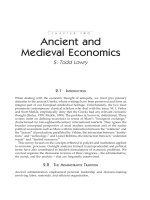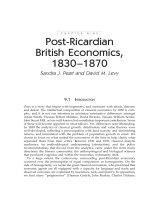A Companion to the History of Economic Thought - Chapter 13 ppsx
Bạn đang xem bản rút gọn của tài liệu. Xem và tải ngay bản đầy đủ của tài liệu tại đây (180.85 KB, 14 trang )
UTOPIAN ECONOMICS 201
CHAPTER THIRTEEN
Utopian Economics
Warren J. Samuels
13.1 THE GENRE
Utopian economics is a distinctive genre of writings, a group of fictional accounts
that can take two forms. A utopia is a good place that is, as yet, no place. A
dystopia can be a bad place that is, as yet, no place; or it can be a pejorative
interpretation of the author’s status quo and its perceived trends. These writings,
typically novels or novelettes, are fictional accounts that purport to describe and
explain a particular community or state. The author usually stresses some prin-
ciple of organization and control that serves as the basis of social, political, and/or
economic structure or culture. The principle may express a particular authorial
concern or theme and is often embodied in a distinctive set of arrangements,
such as the equality of the sexes, reform of marriage, the brotherhood of man-
kind, toleration, reform of the institution of property, emphasis on education,
advocacy and practice of eugenics, the hatred of tyranny, and so on.
In general, each utopian or dystopian community tends to be derivative of the
author’s status quo. It is an extension of the author’s own country, on which it
thereby serves as a commentary. The utopian community reflects that society or,
more precisely, the problems, conflicts, and trends of the times, as perceived,
evaluated, and projected by the author. The community is an extrapolation either
to idealize and eulogize or to satirize and criticize certain aspects of the author’s
experience. The work is an exploration into the human condition and both the
follies and prospects of mankind.
Utopias tend to be systems of consent, either volitional or induced; they also
have solved, escaped, or transcended contemporary problems. Dystopias tend to
be systems of regimented, authoritarian and totalitarian control; they also exhibit
instability and other problems, often of an inhumane character.
A substantial historical, interpretive, and critical literature has developed with the
utopian/dystopian literature as its subject of study (e.g., Hertzler, 1923; Russell,
1932; Buber, 1949; Popper, 1949; Berneri, 1950; Mumford, 1962; Negley and Patrick,
1962; Manuel, 1966, 1971; Eurich, 1967; Hillegas, 1967; Kateb, 1971, 1972; Negley,
202 W. J. SAMUELS
1977; I. F. Clark, 1978; Manuel and Manuel, 1979; Aldridge, 1984; Kumar, 1987;
Sargent, 1988; Booker, 1994a,b; Haschak, 1994; Hetherington, 1997; Mannheim,
n.d.; see also an issue of Daedalus, 1965). Needless to say, interpretations vary, not
least of Sir Thomas More’s seminal work (e.g., Sullivan, 1983). Other literature is
devoted to communities inspired by the utopian literature and impulse (e.g.,
McKinney, 1972; Moe, 1980; Guarneri, 1991). Centers and/or specialized collec-
tions for the study of utopian literature are found at Green Mountain College and
Duke, Ohio, and Pennsylvania State Universities. Specialists may join the Society
for Utopian Studies and the Associazione Internazionale per gli Studi sulle Utopie.
Numerous sites (of various usefulness) are to be found on the web.
13.2 A LARGER CONCEPTION
A Platonic idealist element seems to pervade the exercise of the human intellect.
One source is positivist and another is normative. The positivist source consists
of efforts to distill the transcendent fundamental elements underlying the diverse
and kaleidoscopic phenomena of experience in order to best describe what social
“reality” is really all about. One version of this is Max Weber’s notion of an
“ideal type.” The normative source is grounded in efforts to transform the imper-
fections of actual life into a perfect, ideal system. The latter is clearly a form of
social constructivism; it embodies a philosophy of reform or of potential reform.
The former may not be constructivist in motivation; but, in providing a particular
definition of reality, it willy-nilly becomes the basis of policy and is, at least
to that extent, constructivist with regard to the future. Social constructivism
commences with the provision of a particular definition of reality and extends to
the provision of a basis of policy.
Utopianism may be one form of Platonism in practice. Each utopist writing is
a product, in part, of a belief, conscious or not, in the use of reason to critique and
to re-create.
A feature, perhaps a problem, of idealist thought is that a given experience –
that is, a given social situation, such as England in the sixteenth century or the
United States in the nineteenth century or the 1930s – may give rise to a variety
of idealizations. This is because not only does an actual situation not define itself
but its fundamental elements may be perceived and identified differently by
different people with different standpoints, who then proceed to construct both
different definitions of reality and different pictures of its idealized form. The
constructions are a function of both the particular multifaceted situation and the
diverse imaginations, including values, of those who construct them.
One can interpret the Book of Isaiah and the Book of Ecclesiastes as, respectively,
a utopian and a dystopian account of the human condition; the Book of Revelation
projects a New Jerusalem. One can envision the writings that express Henry
David Thoreau’s return to nature as a utopian enterprise. One can perceive the
agenda of the Enlightenment as utopian in the nonpejorative sense used here.
Science fiction, which is normally considered a literary genre unto itself,
can also embody the utopian/dystopian dichotomy. While much science fiction
UTOPIAN ECONOMICS 203
portrays conflicts and other aspects of life hitherto explored in terrestrial terms
– for example, cowboys versus Indians or ranchers versus farmers, but now
in galactic or intergalactic terms – some portrays utopian and other dystopian
arrangements. Isaac Asimov’s Foundation (1951), for example, explores a utopia
engendered by advanced mathematical social science – and profoundly influenced
at least one economist, Roger B. Myerson (1998, p. 228).
Satire is another literary genre that can overlap (especially) the dystopian
domain. Swift’s Gulliver’s Travels readily comes to mind. So, too, can irony, which
can incorporate and project a utopian basis of judgment.
The motion picture industry has often been portrayed as presenting idealized,
utopian characterizations of life; for example, “veritable machines of escapism
and emotion that promotes images of a utopia in which everyone wants to live, if
only for an instant, by proxy” (Attali, 2000, p. 84). Escapism, however, is not
necessarily utopianism.
Utopianism is also known to the worlds of art and culture studies. In 2000 the
Museum of Modern Art in New York City had an exhibition entitled “The Dream
of Utopia/Utopia of the Dream.” In the words of its promotional literature, the
exhibition considered “the sharp opposition between the radical visions set for
by Surrealism, on the one hand, and by the utopian abstraction of artists such as
Piet Mondrian and Kazimir Malevich, on the other.” And during the period
October 14, 2000 to January 27, 2001, the New York Public Library had an exhibi-
tion entitled “Utopia: The Search for the Ideal Society in the Western World.”
Associated with it was a book of the same title (Schaer, Claeys, and Sargent, 2000;
both the exhibit and the book are reviewed in Grafton, 2000).
Of a different nature are The Good Society by Walter Lippman (n.d.) and The
Economics of the Good Society by Joseph Berliner (1999), each of which explores the
nature of a better economic system. Geoffrey M. Hodgson’s Economics and Utopia
(1999) offers not a conventional utopian blueprint but a mode of utopian thinking.
Hodgson critiques socialism and market individualism as two utopian visions
and illusions. His approach stresses the incompleteness of the concepts of social-
ism and individualism, of private and public, and of the notion of a pure market.
He stresses the importance of debate about the values to be institutionalized in
actual markets and the role of social reform of market structures.
It is quite possible to think of the major schools of economic thought as
Platonic idealizations, even though the disciples of several think of them as
scientific. Thus, mercantilism, physiocracy, classical economics, Marxian and
non-Marxian socialism, neoclassical economics, institutional economics, Keynesian
economics, general equilibrium theory, Austrian economics, and such forms of
economic theory as rational expectations economics, game theory, public choice
theory, monetarism, and so on – indeed, all economic theory – can be compre-
hended as so many idealized representations of a much more complex, and
messy, reality. Each of them is a particular specification of a utopia, with both
affirmative and negative features. The same could be said of Henry George’s
Progress and Poverty (1880), the backward-looking utopias of early-nineteenth-
century economic German and English Romanticism in economics, and the
doctrines of libertarian economics (Tilman, 2001).
204 W. J. SAMUELS
Neoclassical theories of price and market can be Weberian ideal types, methodo-
logically limited formulations, and/or utopian idealist, ideological constructions.
Neoclassical welfare maximization can be seen as an example of utopianism,
however marked by its conventional omission of detailed institutions and however
much neoclassical economists denigrate utopianism (Davis, 1988, p. 13). Through
its emphasis on incremental change, benefit–cost calculations as a mode of
decision-making, and on seeing the best as the enemy of the better, neoclassicism
can be seen as affirming rationalistic, deliberative control of utopian exuberance.
Characterization may be subjective. The general social theory of Friedrich von
Hayek – for example, his theory of spontaneous order – can be seen as (1) anti-
utopian, (2) utopian in its anti-utopianism, and (c) the expression of a particular
utopia.
(The foregoing may seem to equate economics, science, fiction, and utopia/
dystopia, but is intended to do so only in part. All have at least one foot in the
“real world,” but, given multiplicity of interpretation of the “real world,” the
identity of that foot seems always to be an issue.)
Apropos of conservatism in general, three views are possible. First, conserva-
tism is a temperament that values stability and continuity, with no unique con-
servative utopia, preferring to “use and enjoy what is available rather than to
wish for or to look for something else; to delight in what is the present rather
than what was or what may be” (Michael Oakeshott, quoted in Zakaria, 2000,
p. 94). This would relegate utopianism to the “subjective imagination” of those
who dream of “a radically different world” and “fantasise about a radically differ-
ent future,” writers “with vivid imaginations of the best of all possible worlds (or
in a few cases, their dystopian opposite)” (Jay, 2000, p. 23). Secondly, insofar as a
utopia reflects and/or is derived from a particular status quo whose idealization
it represents, at least in part, in that respect, if in no other, it is conservative.
Thirdly, particular conservative ideologies project their own specific idealized –
that is, utopian – version of its status quo.
On the other side of the ideological spectrum, the liberal-left publisher, Verso,
has a series entitled “The Real Utopias Project,” edited by Erik Olin Wright.
One blurb for the series that says it embraces the tension between dreams and
practice, radical solutions to problems, and the pragmatically possible. Among
the book topics are democracy, equal shares/egalitarianism, and universal basic
income.
To the objection that the foregoing (the materials identified in the preceding
five paragraphs) are not fictional accounts, one can respond that, while they
certainly are not novels, each is fictional in the sense that it tells a particular story
not about actual economies but of an abstracted rational reconstruction. Indeed,
all science is fictional in pursuing abstraction and idealization – general models
bearing no necessary relation to actual phenomena and experience. Much mod-
ern economic theory is justified in precisely these terms (for further criticism, see
Negley and Patrick, 1962, p. 3).
Friedrich Engels pejoratively called all versions of socialism other than his and
Marx’s “utopian socialism.” He was referring to such authors as Abbé Morelly,
Saint Simon, Charles Fourier, Etienne Cabet, and Louis Blanc, rather than to all
UTOPIAN ECONOMICS 205
utopists. But in the present context, Marxism is a dystopian representation of
capitalism combined with a utopian portrayal of an economic system in which
workers are no longer subjected to traditional property rights and a successor
system in which they have rights over their own labor power. The writings of
Josiah Warren portray the utopia in which each person is a property owner. The
economics of Henry George includes a dystopia in which low wages and unem-
ployment derive from the acquisition by private individuals of the unearned
increment in the value of land, combined with the vision and promise of a
utopia in which that problem is obviated by his “single tax” on land. Neoclass-
ical economics is an idealization and thereby rationalization of the workings
of a competitive, profit-oriented, materialist, private-property directed market
economy. Given the statement that “Utopia is fiction in the classic sense of ‘as if’;
utopia is a world of as if” (Negley and Patrick, 1962, p. 4), then those who
contemplate a market economy led as if by an invisible hand (not Adam Smith)
are utopists. C. Wright Mills has been called “An American Utopian” (Horowitz,
1983); in his utopia forms of authoritarianism would be absent – as would be the
case with a Hayekian system. An interesting and suggestive deconstruction of
Marx and Hayek’s respective critiques of utopianism is Sciabarra (1995).
In sum, religious and secular utopias (and fear of dystopia) pervade idealiza-
tions found in public discourse in many fields. Some are reactionary (ideological
in Karl Mannheim’s system); others are radical visions of the future (utopia in
Mannheim’s system). The emphasis is always on some definition of reality and
some possibility for change – definitions and possibilities that are not always,
indeed rarely, unequivocal and/or realistic.
13.3 THE LITERATURE AND ITS CHARACTER
Several thousand writings of the conventional genre exist, quite apart from
science fiction. The best known – indeed, classic – literature includes Plato’s
Republic (360 B.C.), Sir Thomas More’s Utopia (1516) (from which the genre
acquires its name), Tomasso Campanella’s City of the Sun (1637), Francis Bacon’s
New Atlantis (1626), Gerrard Winstanley’s The Law of Freedom in a Platform (1652),
James Harrington’s The Commonwealth of Oceana (1656), Henry Neville’s The Isle of
Pines (1668), Jonathan Swift’s Gulliver’s Travels (1726), Robert Owen’s A New View
of Society (1813–14) and Report to the County of Lanark (1821), Etienne Cabet’s
Voyage to Icaria (1840), Samuel Butler’s Erewhon (1872), Edward Bellamy’s Looking
Backward (1888), Theodor Hertzka’s Freeland (1891), and H. G. Wells’s A Modern
Utopia (1905) and New Worlds for Old (1908). Less well known are Denis Diderot’s
Supplement to Bougainville’s Voyage (1796), and William Morris’s News from
Nowhere (1891).
This literature – both the conventional genre and the extended group – can be
understood as a part of the social valuational process, often but neither neces-
sarily nor only, with regard to justice. Each piece provides a selective critique (in
the sense of literary criticism) of a particular status quo either as received or as
developing. This literature is an important vehicle for the expression of and quest
206 W. J. SAMUELS
for values. Each piece contributes in its own way to the exploration, identifica-
tion, application, and critique of values. This literature is an important means
by which authors can produce and express views for or against socio-politico-
economic change.
This literature also can be understood not only as a quest for values but as a
parallel and not unrelated quest for meaning. Each utopia or dystopia is an
allegorical expression of a culture or civilization as individuals seek to divine its
meaning; seeking, in part, a comprehension of its powers and its possibilities.
Latent within the members of every society are visions of the ideal and the just
(and other values) and accounts of meaning. Some visions rise to the level of
consciousness and become ensconced in the conscious, or self-conscious, utopias
(dystopias) of a Godwin, a Saint-Simon or a Fourier; these visions are dreams,
dreams of different futures, whose significance does not depend on their being
directly acted upon (T. J. Clark, 2000, p. 9). They form a not inconsequential part
of human intellectual baggage.
Accordingly, one can say, speaking quite broadly, that the main concern of this
literature is the pursuit and achievement of human dignity (including “justice”)
in a well-ordered society. However, the meanings of both “human dignity” and
“well-ordered society” are ambiguous and permit a great variety of specification.
The problem is always one of stipulating the structure and system of freedom
and control, with freedom both correlative to and derivative of control. This is no
less true of the utopian/dystopian literature than of the literature of philosophy
and social science.
While each piece of utopian/dystopian literature is a product of its times, a
particular status quo can engender quite different utopias/dystopias. This is the
case for at least two reasons: (1) each society or social status quo is heterogene-
ous and thus permits divergent perceptions and emphases; and (2) individual
authors approach, interpret, and evaluate their society from different standpoints
or perspectives. Thus, while conservative authors use the device to support
established ideas, institutions, and ways of life, and radical authors employ the
device to advocate change, each author is selective as to particular details and
thereby contributes to both continuity and change.
Each author constructs their utopia or dystopia on the basis of some particular
principle of organization, albeit typically supplemented by other ideas or themes.
Among the principal historic types of principle are: religion, natural science,
military organization, asceticism, political principle, and economic organization.
The twentieth century – not without precursors, such as Looking Backward – saw
a new type of principle, psychological or behavioral conditioning, found in Aldous
Huxley’s Brave New World (1932), B. F. Skinner’s Walden Two (1948), George
Orwell’s 1984 (1949), and Ray Bradbury’s Fahrenheit 451 (1953). These tend to be
dystopias, as are Matt Cohen’s The Colors of War (1977), Hugh MacLennan’s
Voices in Time (1980), and William Gibson’s Count Zero (1986). Ayn Rand’s Atlas
Shrugged (1957), which combined utopian and dystopian features, has influenced
some, perhaps many, young economic thinkers.
Some writings are speculative and constructive (Plato, Bellamy); others are
satirical and critical (Huxley, Orwell). Some are futuristic and progressive; others
UTOPIAN ECONOMICS 207
are retrogressive or reactionary, looking to reinstate a former condition of society,
usually a nostalgic, idealized version (Negley and Patrick, 1962, pp. 5–6).
13.4 THE LITERATURE AND ITS EVOLUTION
Negley and Patrick (1962, pp. 6–8; cf., Hertzler, 1923; Kumar, 1987) distinguish
between those utopias in which power is centralized and those in which power
is decentralized. Progressive utopias tend to emphasize centralization and
retrogressive, decentralization. The matter is subtle. Power is conspicuous when
used to produce change and in articulating a new system. A revered old power
structure is easily obfuscated by taking it for granted as part of the natural order
of things. In either case, power may involve either an idealized new and different
power structure or an idealized version of an old power structure.
It is difficult to generate a conclusive classification: each utopia is a product
of a creative imagination applied in reaction to a complex set of experiences
and phenomena. Nonetheless, Negley and Patrick distinguish between utopias
written before and after roughly 1850 (their analysis is more elaborate than is
presented here).
Utopias written during the period 1500–1850 tend to be characterized by
decentralization of power, opposition to industrialization, and emphasis on the
individual and ideal interpersonal relationships. Institutions are often denigrated
and proper or ideal interpersonal relationships are put forth as the sine qua non of
the good society. Although it is possible to argue that their “main theme . . . was
advocacy, explicit or implicit, of the fullest possible, efficient utilization of the
available resources of men and materials in a given society” (Negley and Patrick,
1962, pp. 290–1), economic considerations – scarcity, economic organization, and
control – while not absent, are largely neglected, certainly in comparison with
later utopias. Generally, the earlier utopias posited the “idea of a self-sufficient
community of simple and uncomplicated economic structure, happy in the
enjoyment of simple values of artisanship, family, and natural piety” – a vision
that later became “the vehicle of satire or nostalgia” (Negley and Patrick, 1962,
p. 13).
After roughly 1850, utopias are characterized by centralization of power, primacy
of attention given to economic organization and control, the acceptance of indus-
trialization and urbanization, emphasis on proper institutions as the basis of the
good society and the full development of the individual, and anticipation of the
welfare state.
As already noted, differentiation by period cannot be absolute; every charac-
terization has its exceptions. Utopias always have been diverse in content, as well
as sometimes dystopias. The increased importance of the economy in generating
an organizing principle reflects the increased importance and differentiation
of the economy and economic institutions – which means that both utopists
and economists learned from and gave effect to modern economies. Increased
centralization of power may actually reflect the arguable increased centralization
in modern economic life. Since about 1850 the general problem has been that of
208 W. J. SAMUELS
promoting individualist values in a society with the institutional arrangements
suitable to the conditions of mass production and mass consumption; that is, the
problem of working out the meaning of individualism in modern bourgeois or
nonbourgeois terms.
It seems that no utopias were written during the medieval period. If true, this
may be due to the theological or mythopoetic mode of expression. Theology or
supernaturalism is not only an alternative outlet for utopist strivings, but is the
ultimate utopian literature. Another cause may be the medieval ideal of a static
divinely sanctioned order, an ideal elevating continuity over change – notwith-
standing the widespread actual changes then taking place, such that reification
and idealization was of a changing reality. With the coming of the Renaissance
and the Enlightenment – the actual history is more complicated than this –
rationalism, humanism, naturalism, secularism, and individualism nurtured a
revival of utilitarianism–pragmatism–instrumentalism and deliberative con-
structivism, aiming at progress, elevating change over continuity. Ruling classes
had always been pragmatic and constructivist; with a growing consciousness that
institutional arrangements were artifacts and were subject to change, the utopian
urge was given freer, or at least wider, rein [although the emphasis on human
social construction, over against divine origin, is found in More’s Utopia – a point
stressed by Grafton (2000, p. 4) – if not also in Plato’s Republic].
Steven Weinberg (2000) has suggested that five nonsocialist types or styles
of utopia seem to be emerging in public debate: the free-market utopia, the
best-and-brightest utopia, the religious utopia, the Green utopia, and the techno-
logical utopia – and he offers his own “civilized egalitarian capitalist utopia.”
13.5 ECONOMICS IN THE UTOPIAN LITERATURE
Utopist authors are more like social than economic theorists, and what econo-
mists of all schools would recognize as coming within their purview will vary,
in part because of their diverse interests and perceptions, in part because of the
heterogeneity of the ideas presented in the literature of utopia and dystopia, and
in part because the central orientation and arguments, as it were, differ between
utopias and dystopias. It is really impossible to generalize without exceptions. In
general, however, economic ideas per se are much less important and salient than
broadly political, social, and psychological ideas; ideas of political economy (as
distinct from economics) are present, though typically largely implicit.
One pervasive theme is the importance of organization and structure. These
authors do not project a pure conceptual a-institutional picture. Their overwhelm-
ing emphasis, often down to, if not centering upon, particular organizational
details, is on structure.
Readers will find individualist and collectivist, or liberalist and socialist,
features and themes. Among the individualist themes are enthusiasms for
individual initiative, self-reliance, and self-development; economic (as well as
political) criticisms of the state; and notions of spontaneous social order and
harmony, once the proper set of institutions has been put in place. Among the
UTOPIAN ECONOMICS 209
collectivist themes are a hatred of the institution of private property and notions
of class exploitation and domination. Still, whereas many criticize private property,
others, such as Josiah Warren, propose a widespread distribution of property.
Problems of class and inequality are frequent foundations for authorial motivation
and design.
Nonetheless, for all the individualism and humanism to be found in this
literature, appropriate social control is the core of the messages propounded by
the utopist authors. The frequent anarchistic strains relate in part to psycholo-
gical antipathy toward authority, especially its abuses, and in part to political
antagonism toward concentrated political and economic power. Yet each utopian
design has its own system of social control.
Frequently found ideas include various versions of the labor theory of value,
but also – albeit to a lesser extent – an implicit reliance on properly structured
markets. Also found are exploitation theories of property, state, religion, wealth
and income distribution; beliefs in the destructive character of competition,
unless properly institutionalized, and materialism. Some form of an ethical
maldistribution theory is frequently encountered. Given the emphasis on the
proper organization and control system, absent such system income and wealth
may be distributed in such a manner and with such a result as to be unethical
and unjust. Institutionally produced inequality is unjust, and poverty is inherently
wrong and morally offensive in the face of great wealth. Often this inequality is
attributed to ruling-elite control of the organs of social control.
Another idea, found, for example, in the work of Charles Fourier, is that the
proper organization of life would promote abundance.
In various ways, therefore, utopist writers parallel political, economic, and
social theorists (each a very diverse group) in the topics of their concern.
13.6 INTERPRETATION AND CRITIQUE
Utopist authors seem, individually and collectively, to have understood and posed
certain basic questions: the status of the status quo, the distribution of power as
a central problem, the quality of life, the quality of human beings as a product of
the system, the process of leadership selection (including education for leadership),
the dangers of extreme division of labor, the artifact nature of social institutions
and their susceptibility to deliberative human modification, and the social
valuation process. These authors, each in their own way, helped provide checks
on their respective status-quo societies and articulations of values and of the
possibilities of social change.
The conventional criticism of utopianism, and thereby the source of the pejora-
tive use of the term, is that the utopist author is unrealistic as to how much social
change is possible. This may well be true, though it may also be said that the
authors so much appreciated the difficulties that they felt that their writing would
help foment change. Bellamy’s Looking Backward, in particular, sold millions
of copies and apparently had enormous influence in providing the mental or
ideological foundations for social reform.
210 W. J. SAMUELS
The more interesting and more important criticism is that the typical utopia
makes no provision for serious conflict and/or change once its system is put in
place. It is a static once-and-for-all-time reconstruction. In this respect, it is equi-
valent to a libertarian laissez-faire in which the only function of officials is to see
that the laws are kept, not to introduce social change. If change signifies change
through law, as it often does in actuality and in instituting the projected utopia,
then afterward there is nothing left for change through law to accomplish. It has
been said that life in a utopia would be dull, for there would be no problems to
solve (Harris, 1977, p. 74), and that “All the utopias are tame, just because vitality
has been sacrificed to reduce risk” (Hartshorne, 1949, p. 448). It is not too much
to think that some of the impetus behind the construction of a utopia is its
author’s effort at escapism from conflict and the ongoing necessity of choice in
working things out.
The fundamental “utopian” character of this literature, in the pejorative sense,
lies in its general neglect of the problem of change within the respective systems.
The critical problem with this literature is not how difficult it is to generate
change but that, typically, no further change is contemplated once the proposed
system is put in place. This is often manifest in the human desire to establish the
proper system or framework and then let it operate on its own accord, allowing
individuals to act within it, with the confidence that the system will generate
harmony, correct behavior, and the right goals.
This is too simplistic and disengaging a view of the complexity of real-world
problems, the dynamics of change, and the need for collective decisions. Or, as
Hertzler argued, social perfection is an illusion; there can only be social progress;
“Utopia is not a social state, it is a state of mind” (Hertzler, 1923, p. 314).
Still, some utopists have considered the problem of change within their utopia.
H. G. Wells is one author who did. Another (emphasized by J. C. Davis in Schaer,
Chaeys, and Sargent, 2000), was More, who adopted a model of cumulative
causation in which institutions helped to transform human nature and this
in turn led to changes in institutions. And, inasmuch as many utopias have
actual and/or potential contradictory elements, change within utopia is a logical
possibility.
Per contra, one could argue that one function of utopist writing is to point out
contradictions and faults in the author’s society. Identifying a possible solution
and contemplating it without change, under what amounts to a rule of “as is” or
ceteris paribus, is a deft and heuristically useful mode of analysis – in literature
and in science.
A correlative problem is that the posited utopia may not work out as intended,
and for this if for no other reason may require institutional adjustments.
Perhaps second only to the problem of the neglect of change within the
utopian system, and not unrelated thereto, is the temptation to hold that only
one answer or solution is either possible or warranted for all problems, that only
one utopia is possible. This begs the question of the possibility of diversity both
within and between utopian societies. However, the neglect of both change and
diversity can be attributed to the nature of the genre. Fiction can go only so far,
presumably, in articulating alternatives; and literary license in such matters is
UTOPIAN ECONOMICS 211
neither unexpected nor to be condemned. Still, the utopian mentality may derive
not only from a belief that one has found the solution to social problems but also
from a desire to escape the burden of choice.
Another aspect of the complex dynamics of social change relevant to utopias is
that social change toward an idealized image is often not perceived as change.
The more successful a utopist, therefore, in altering a people’s idealized image,
the less the utopist’s role will be recognized.
Although post-1850 utopias seem to have focused more on economic organ-
ization, overall one can say that the utopian literature has generally neglected
problems of economic organization and control. Yet, most writers seem to have
appreciated the need to organize production (though for some production is
unimportant). As for the importance of distribution and incentives, two views
are possible, often varying between writings: such considerations can appear to
have been neglected; they may also be held to be a function of both institutions
and the goals of the particular utopist author.
Correlative to the conventional criticism, one can say that the utopist authors
failed to anticipate the opposition by the vested interests that their schemes
threatened. Here, too, two views are possible: that they did fail to anticipate
opposition, and that they considered their writings a device with which to
challenge and weaken opposition (in some cases, with hoped-for immunity from
persecution).
Another criticism is that the authors oversimplified the nature of human
nature and exaggerated the possible impacts of changes in social institutions.
Again, two views are possible: that the writers were naively over-optimistic, and
that they were underscoring and enhancing the possibilities, however limited
they might be – and/or that they sought to provide a check on the institutions
that affected how human nature works out.
It should also be pointed out that utopist authors typically have complex
notions of the nature of human nature – certainly in comparison with the conven-
tional model deployed by most economists.
A powerful criticism, itself the basis for many dystopias, is that serious change
may require concentrated power, a corollary of which is that any concentrated
power (public ownership and mandatory central planning) is likely to engender
abuse. This criticism is not unique to utopias, of course; it is a general social
pathology. The totalitarian or authoritarian temptation, however, is not limited to
utopian movements. The history of the genre is laden with ironies. For example,
although Thomas Robert Malthus wrote his Essay on Population (1798) in criti-
cism of William Godwin’s emphasis in his Enquiry Concerning Political Justice
(1793) on the moral improvement of man, in subsequent editions Malthus emph-
asized the preventive checks, including moral restraint. An irony of a different
type is that for all their attention to specific arrangements, their overall import is
not their blueprints but their “hazy recognition of the concrete potentialities and
capacities immanent in what we already have” (Merrifield, 2000, p. 45). Thus,
Hannah Arendt argued, in the words of one commentator, that “utopianism is
grounded in the kind of political thinking that relies on the model of man in the
singular as homo faber, who can fabricate his world, rather than men in the plural
212 W. J. SAMUELS
as political actors who can only contest it from a partial point of view” (Jay, 2000,
p. 24). The opposite position, of course, is that the utopists are merely contribut-
ing their input to the process of working things out, in part by bringing out into
the open and treating deliberatively what would otherwise be only latent and
monopolized by established interests.
The significance, therefore, of the utopian literature resides in the following. It
articulated values and possibilities; it has been idealism in literary practice. It has
given vent for the imagination to develop possibilities for change. The utopian
literature has emphasized the proposition that institutions matter. It has increas-
ingly focused on the importance of psychology and the problems of identifica-
tion and alienation in regard to the particulars of any status quo. It has focused
on the problem of individualism within any given institutional structure. It has
thereby raised the problems of power structure and the division of power. It has
raised the question of the concentration of power both within a given utopia and
in the process of creating an actual utopist society – including issues of utopian
ends and of conflict resolution.
The utopian literature has, in effect, sought to provide answers to the problem
posed by Jeremy Bentham’s greatest happiness principle; namely, whether hap-
piness is to be maximized by increasing the happiness of those made most happy
or of the number of people made happy – that is, along the intensive or the
extensive margins. In this respect, for all the greater centralization of power in
modern utopias, many if not most authors have nonetheless sought to maximize
the number of people made happy; that is, political and economic pluralism. But,
again, the literature is so diverse that one must be wary of overemphasizing any
single generalization.
A final principal problem is that the utopias promulgated by the various utopists
are many and varied, indeed highly heterogeneous. This is, again, because of the
heterogeneity of every status quo, the variety of authorial interpretive perspectives,
and the fecundity of the human mind. Utopianism is idealism in practice and the
enormous burden of idealism is the choice among apparent possible proposals
for change. Utopist authors have helped promote the possibility of change, but
have thereby compelled us to choose among quite different possibilities.
Bibliography
Aldridge, A. 1984: The Scientific World View in Dystopia. Ann Arbor, MI: UMI Research
Press.
Attali, J. 2000: How Hollywood rules. Civilization, February–March, 644–65.
Berliner, J. S. 1999: The Economics of the Good Society. Malden, MA: Blackwell.
Berneri, M. L. 1950: Journey Through Utopia. London: Routledge and Paul.
Booker, M. K. 1994a: The Dystopian Impulse in Modern Literature: Fiction as Social Criticism.
Westport, CT: Greenwood Press.
—— 1994b: Dystopian Literature: A Theory and Research Guide. Westport, CT: Greenwood
Press.
Buber, M. 1949: Paths in Utopia. London: Routledge and Kegan Paul.
Clark, I. F. 1978: Tales of the Future, from the Beginning to the Present Day. London: The
Library Association.
UTOPIAN ECONOMICS 213
Clark, T. J. 2000: Reservations of the marvellous. London Review of Books, June 22, 3–9.
Daedalus 1965: Utopia. Daedulus, 94(2) (Spring).
Davis, J. B. 1988: Looking Backward: looking forward. Forum for Social Economics, 17(2), 13–
22.
Eurich, N. 1967: Science in Utopia: A Mighty Design. Cambridge, MA: Harvard University
Press.
George, H. 1880: Progess and Poverty. New York: D. Appleton.
Grafton, A. 2000: Over the rainbow. The New York Review of Books, November 30, 4–6.
Guarneri, C. 1991: The Utopian Alternative: Fourierism in Nineteenth-Century America. Ithaca,
NY: Cornell University Press.
Haschak, P. G. 1994: Utopian/Dystopian Literature: A Bibliography of Literary Criticism.
Metuchen, NJ: Scarecrow Press.
Harris, J. 1977: William Beveridge: A Biography. New York: Oxford University Press.
Hartshorne, C. 1949: Chance, love, and incompatibility. The Philosophical Review, 58 (no. 55),
429–50.
Hertzler, J. O. 1923: The History of Utopian Thought. New York: Macmillan.
Hetherington, K. 1997: The Badlands of Modernity: Heterotopia and Social Ordering. New
York: Routledge.
Hillegas, M. R. 1967: The Future as Nightmare: H. G. Wells and the Anti-Utopians. New York:
Oxford University Press.
Hodgson, G. M. 1999: Economics and Utopia: Why the Learning Economy is Not the End of
History. London: Routledge.
Horowitz, I. L. 1983: C. Wright Mills: An American Utopian. New York: The Free Press.
Jay, M. 2000: The trouble with nowhere. London Review of Books, June 1, 23–4.
Kateb, G. (ed.) 1971: Utopia. New York: Atherton Press.
—— 1972: Utopia and Its Enemies. New York: Schocken Books.
Kumar, K. 1987: Utopia and Anti-Utopia in Modern Times. Cambridge, MA: Blackwell.
Lippmann, W. 1956: The Good Society. New York: Grosset’s Universal Library.
Mannheim, K. n.d.: Ideology and Utopia. New York: Harvest Books.
Manuel, F. (ed.) 1966: Utopias and Utopian Thought. Boston: Houghton Mifflin.
—— (ed.) 1971: Design for Utopia: Selected Writings of Charles Fourier. New York: Schocken
Books.
—— and Manuel, F. P. 1979: Utopian Thought in the Western World. Cambridge, MA: The
Belknap Press.
McKinney, M. 1972: Modern Communes, Utopian Societies, Utopian Thought: A Selected
Bibliography of Green Mountain College Holdings. Poultney, VT: Green Mountain College
Library.
Merrifield, A. 2000: No exit? Dream on. The Nation, June 5, 44–9.
Moe, C. 1980: New Towns and Utopias. Monticello, IL: Vance Bibliographies.
Mumford, L. 1962: The Story of Utopias. New York: Viking.
Myerson, R. B. 1998: Working on game theory: a personal perspective. In M. Szenberg
(ed.), Passion and Craft: Economists at Work. Ann Arbor, MI: University of Michigan
Press, 227–33.
Negley, G. 1977: Utopian Literature: A Bibliography with a Supplementary Listing of Works
Influential in Utopian Thought. Lawrence, KA: Regents Press of Kansas.
—— and Patrick, J. M. (eds.) 1962: The Quest for Utopia. Garden City, NY: Doubleday
Anchor.
Popper, K. 1949: The Open Society and Its Enemies. London: Routledge and Kegan Paul.
Russell, F. T. P. 1932: Touring Utopia, The Realm of Constructive Humanism. New York:
L. MacVeagh, Dial Press.
214 W. J. SAMUELS
Sargent, L. T. 1988: British and American Utopian Literature, 1516–1985: An Annotated Chrono-
logical Bibliography. New York: Garland.
Schaer, R., Claeys, G., and Sargent, L. T. (eds.) 2000: Utopia: The Search for the Ideal Society
in the Western World. New York: Oxford University Press.
Sciabarra, C. M. 1995: Marx, Hayek, and Utopia. Albany, NY: SUNY Press.
Sullivan, E. D. S. (ed.) 1983: The Utopian Vision: Seven Essays on the Quincentennial of Sir
Thomas More. San Diego, CA: San Diego State University Press.
Tilman, R. 2001: Ideology and Utopia in the Social Philosophy of the Libertarian Economists.
Westport, CT: Greenwood Press.
Weinberg, S. 2000: Five and a half utopias. The Atlantic Monthly, January, 107–14.
Zakaria, F. 2000: Whimper on the Right. The New Yorker, June 5, 85–90.









